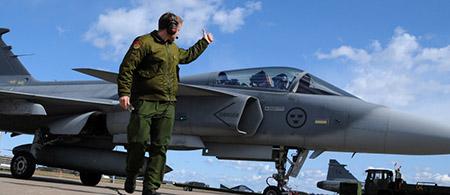For the Sputnik agency, one of the most elegant in commenting on the governor's expressions, Schelin-Seidegård "has slept badly this night, completing the work on the wrong side".
But what did the governor of the island of Gotland say?
"Gotland has always been the weak link in Swedish defense. The government has decided to fortify it, equipping it with missile batteries, able to protect our ships en route to St. Petersburg and target offcoming carriers ".
Comment from Sputnik "Does Mrs Schelin-Seidegård seriously believe that Russia is trying to invade the Baltic countries and threaten Sweden? Do you really believe, this woman impatient to fight the Russians, that her island can really play a strategically important role if we attack? What we do, others do it too. We do simple military exercises, but that does not mean we are preparing for an invasion. So, we could also think of the United States and its continuous exercises that take place all over the world. The governor, this night, will have slept badly, completing the work by getting up on the wrong side ".
The Russian media, therefore, did not really like the governor's sentences, but they err in considering Gotland irrelevant. The key to Sweden's defensive strategy is precisely the Gotland Island. If well guarded and defended, no enemy can attack Swedish soil. However, if Gotland falls, an enemy could dominate all of Sweden with tactical missiles.
.jpg) The Swedish military apparatus is based on the ability to move troops and equipment quickly along prescribed routes crossing the country. The "combat engineer battalions", for example, are deployed at the base of Eksjö in the south of the country, while heavy artillery as well as the Norrbotten Regiment infantry are deployed to Boden in the north. This means that to reach Gotland from Boden you should travel 1000 km.
The Swedish military apparatus is based on the ability to move troops and equipment quickly along prescribed routes crossing the country. The "combat engineer battalions", for example, are deployed at the base of Eksjö in the south of the country, while heavy artillery as well as the Norrbotten Regiment infantry are deployed to Boden in the north. This means that to reach Gotland from Boden you should travel 1000 km.
The troops then, to reach the island should embark at the port of Nynäshamn. There would also be another infantry unit, distant 200 km inland from Sweden, but it should still embark first to reach Gotland. Considering the preparations and the journey, the Swedish units would reach Gotland in four to five days, which was considered sufficient to allow the Russians to fortify the island.
Each Swedish boat would then sink even before reaching the shore. Gotland (now defended by 300 volunteers of 32 ° Gotland Battalion), according to the new doctrine, should host a brigade equipped with tanks, mechanized infantry, artillery, air defense systems, engineers and logistics. Another two similar brigades should be located in the north and south of the country.
Gotland Island would then receive two mechanized infantry battalions equipped with CV-90, two heavy-duty companies equipped with Leopard 2, UAV support, an Archer artillery battalion and a defense battalion with long-range anti-aircraft missile systems as well as complete logistics.
This force would have half the power of that deployed during the Cold War, but it would be strong enough to resist a Russian attack (at least until the Americans arrived).
Franco Iacch
.jpg)
(photo: Swedish Armed Forces)












